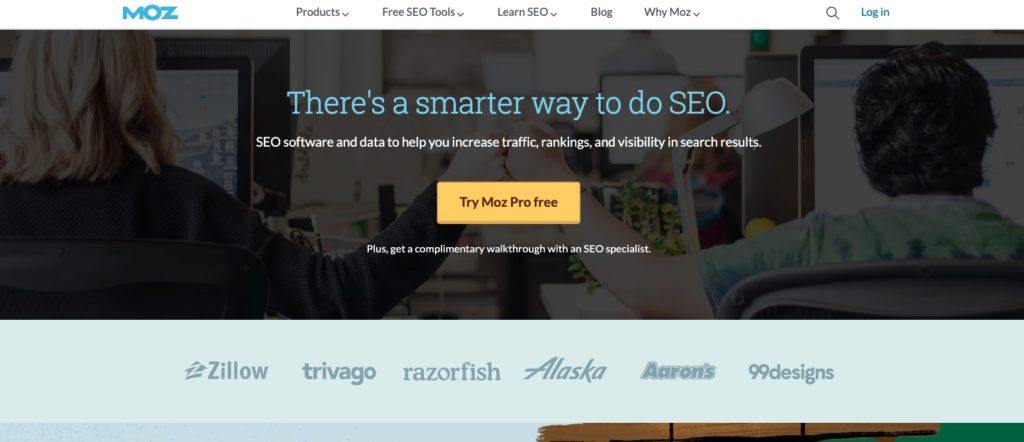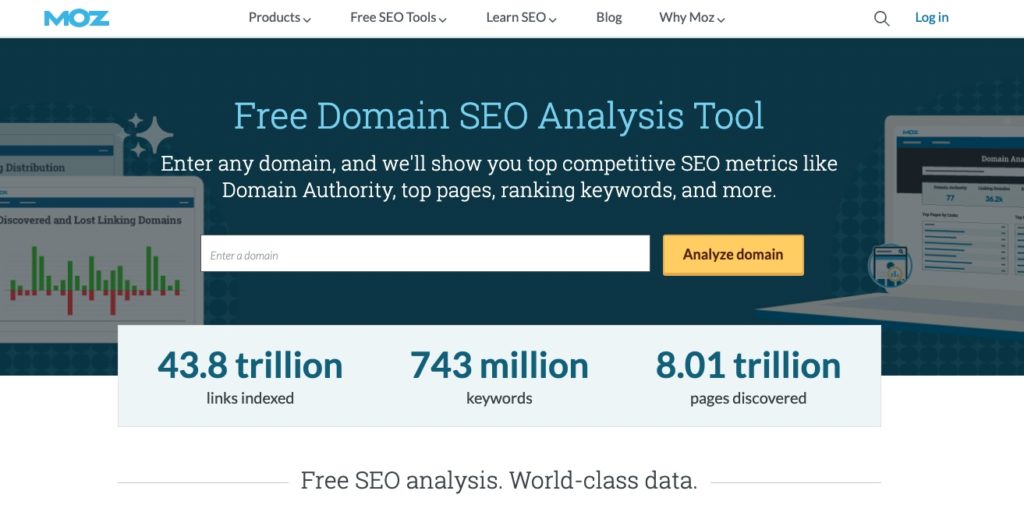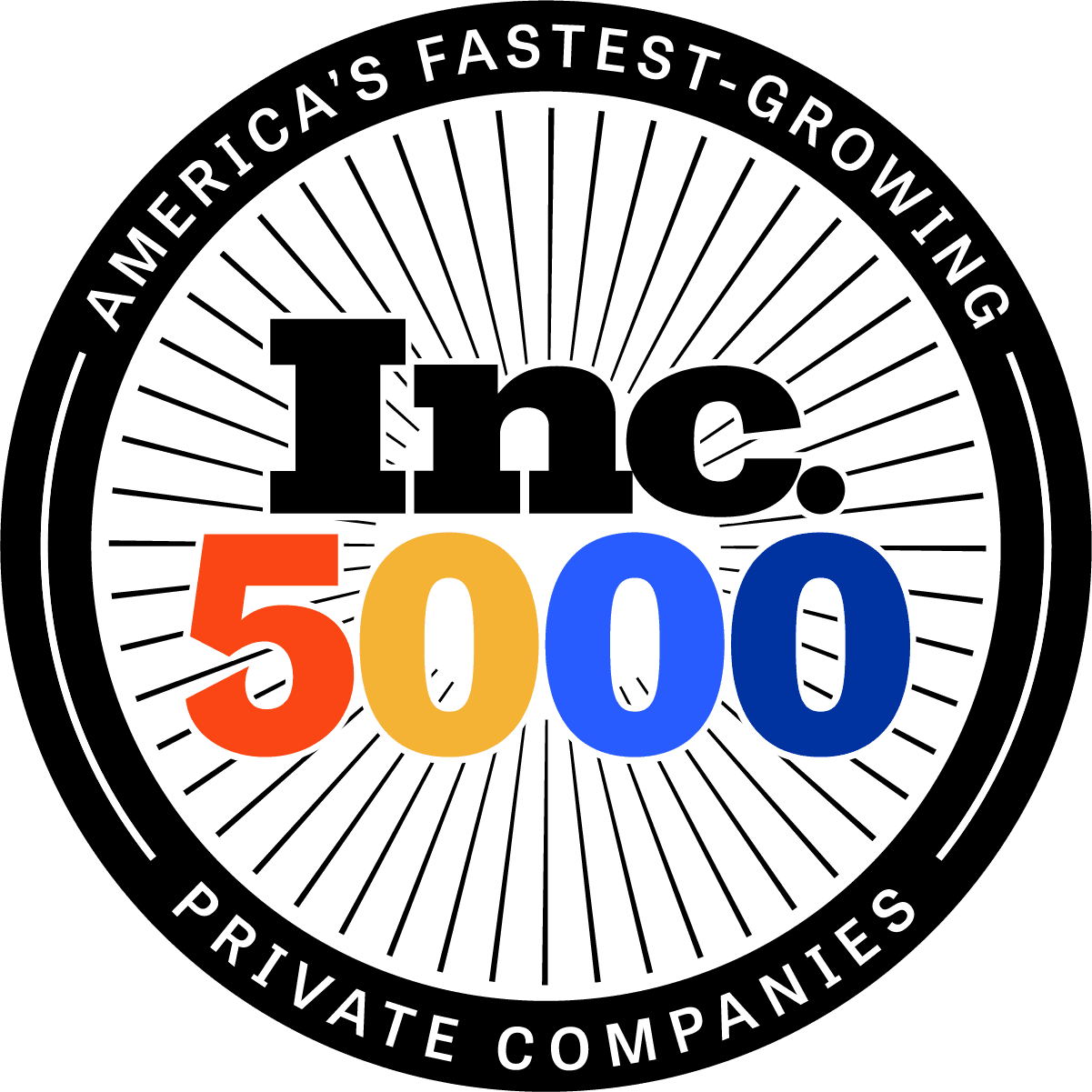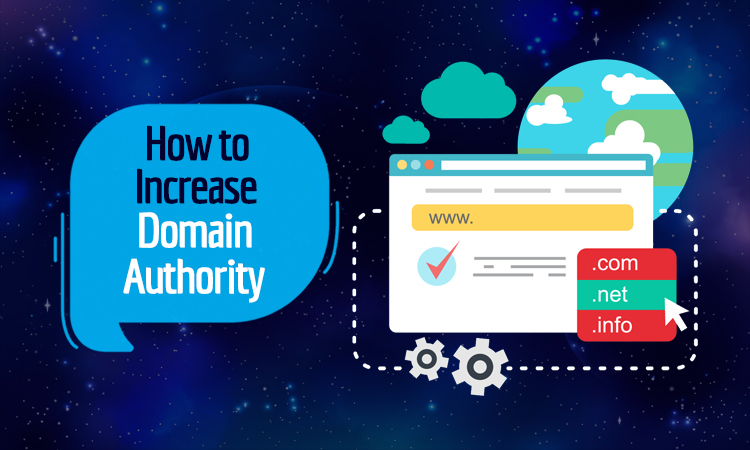Google’s ranking algorithm is technically top-secret. No one outside of the business knows the exact formula and this algorithm changes, sometimes drastically, from year to year.
It’s important for website owners, from enterprise-level to niche website owners, to have a feel for how well they are doing relative to their competitors. But how? There is a marketing tool called Moz that has developed its own algorithm that makes an educated guess.
This educated guess is called domain authority and it can give you a good idea of where you stand. So keep reading to learn more on how to increase domain authority on your website.
Now, before we get further into this, let me start by saying that a website’s DA does not directly correlate to better rankings. You can have a high domain authority site that is low quality, just as a low DA site could be generating a lot of relevant traffic. So, do not use it as the main KPI.
What is Domain Authority?

First, who is Moz, anyway?
Who are they and what gives them the authority to make something called domain authority?
The company was founded back in 2004. Search engine optimization was still in its infancy. At this time, Moz was just a blog that blossomed into its own ecosystem.
They are now the “grandpappies” of SEO. And over the course of nearly 20 years, they’ve studied and tested their way to getting pretty close to what makes Google tick.
They discovered that to increase your domain authority (DA), you needed to do a lot of link building, with a focus on high-quality links.
Domain Authority – What is this Magical Beast?
Domain authority is a beast. But it isn’t magic at all. It’s two decades of testing and a bit of guesswork that gives website owners a general idea of where they stand with search engines.
At its core, domain authority is a metric. It’s a big deal to marketers but it’s not the end all be all of your website or your SEO. That’s not its job.
The purpose is for comparison mostly. The business world is a lot like being chased by a bear in the woods. You don’t have to be the fastest runner in the world. You just need to be faster than the other guy.
If you have a retail business in Nashville and your website has a domain authority score of 25, you might freak out a bit. You may not think that’s a good domain authority score. After all, That’s a pretty low number.
But if your competition’s web pages all have DA scores that are less than 20, you’re probably going to outrank them provided you’re doing everything else right on your web page.
A beautiful, professional website is only going to take you so far. SEO is only going to take you so far. At the end of the day, you need to offer a quality service that’s better than your competition. Everything else just helps with marketing your product or service.
If domain authority isn’t everything, then why should anyone care about their score?.
Why Should You Care About Domain Authority?
Business owners care about everything that has to do with their business. Every CEO, mom-and-pop shop, and affiliate marketer strives to be better than the competition.
It’s not enough to be successful, they have to win. They have a need to be number one.
Have you ever met an entrepreneur that said they were fine with mediocrity? Maybe you have, but they are the overwhelming minority of the business world.
Metrics like domain authority and page authority give business owners an idea of how far they are from the top – or at least a quick way to size up the competition. Marketing professionals, like SEOs, are there to help guide them the rest of the way.
As an example, let’s say you own a jewelry store. Lots of people own jewelry stores, right? You often search for your business on Google but you are rarely on the first page of the search engine result pages.
You hear about Moz and sign up for a free trial to check your da score. It’s abysmal. Horrendous even. Other websites are crushing the game and you’re falling behind.

It’s no wonder the competition is outpacing you! But what do you do now? You go to an SEO professional. They’ll help to educate you on what you can fix and what other people might need to fix for you. This is your first step to leveling up your company. That’s why you should care.
Marketing Tools Aren’t Google
It’s important to note that Google is not an SEO tool and SEO tools are not Google.
These tools are meant to help you get a better understanding of where and how you stack up against your competition and their domain authority scores. However, if you earn quality links to try and boost your DA score, you will likely see an increase in your rankings.
What matters most is getting organic traffic to your website, pushing this traffic down the sales funnel, and then finally making a sale. As long as you’re not breaking Google’s policies, do whatever works best for you and your business.
Domain Authority VS. Page Authority
Page authority is another metric that is somewhat similar to domain authority. Instead of determining how well your entire domain will rank in search engines, page authority ranks individual pages.
The page authority metric can be helpful in determining how likely your blog posts and other pages are to rank (again, assuming you have done on-page SEO correctly). You and your competition are likely going after a lot of the same keywords, so keeping an eye on this metric can be a good idea.
But try not to focus on it too much. There are multiple ways to increase your website’s domain authority and traffic- stressing out over them isn’t one of those ways.
Domain Authority Score – What You Need to Know
Domain authority (DA) is calculated on a logarithmic scale from 1-100. What this means is that the higher your da score goes, the harder it is for your website domain authority to get to the next number.
Think of it in exercise terms. You decide to get healthy and start doing push-ups every day. At first, you can barely do a single push-up. But over time, you’re able to do more and more. First, you get to ten, then twenty.
However, at some point, you’re going to hit a wall. You won’t be able to crank out an extra five or ten push-ups just because you want to. Every push-up after 50 or 60 is going to take all the strength you have left in your body.
So it took you a month to go from one to 20 push-ups per day. But it’ll probably take you six months to get to 40 and then a year to get in 100 a day.
Getting your website’s domain authority to 10 or even 20 isn’t going to take much work. But once you hit a da score of 40, it takes a lot of effort on your part for your web page to go up in DA score. And that’s ok. Maybe your website doesn’t need to go higher.
Once again, a lot of it depends on your competition. If you are building links to a national law firm, you are going to need more authority than if you have a single-location business in a small town.
Knowing you need a boost is one thing, following through and improving your MOZ domain authority is another, so let’s look at how to get it done.
How is Domain Authority Calculated?
Moz calculates your domain authority score with a combination of 40 different metrics, each one containing a different amount of weight within the algorithm.
All of it is brought together and gives you a good idea of where you are and you can use Moz as well as other marketing tools to find out where you are lacking.
Here are the top metrics used to come up with your domain authority score:
- Linking Root Domains – You have 25 links going back to your website. Not too shabby. Unfortunately, they’re all from the same website. In the eyes of Moz, you have one link in this category
- MozRank – Linking root domains is all about the number of links pointing back to your site. MozRank is a metric that scores the quality of those links. Getting a link from a website that has a higher domain authority than you is better than getting two low-quality links from websites with a lower score
- MozTrust – Quality is great. Trust is better. Moz, as well as Google, like to see inbound links coming from the most trustworthy websites on the internet.
- Quality Content – Google wants fresh, up-to-date content. Because that’s what their users want. They don’t want to know about the best skin care products or laptops from 2017. They want to know what the best products are today. If the content on your website is stale or you don’t have a regularly updated blog, then your rankings and your website’s domain authority could suffer.
- Overall SEO – There are two types of SEO. They’re often referred to as on-page SEO and off-page SEO. Control of your off-page efforts is limited but the on-page stuff is 100% under your control. Mastering both will help take your website to new heights.
These metrics, as well as several others, combine to form the score that is your domain authority. You can see that one of the biggest factors is links – especially those from high-authority websites.
Now, let’s take a quick look at how to check your website’s DA, followed by some actionable tips to improve it.
How Do I Check My Domain Authority Score?
Moz makes it easy to check your domain authority score as well as the score of your competition. All you need to do is go to the Moz Link Explorer page and follow the simple instructions. It’s free, but you will have to create an account.
If you want something even easier, check out MozBar. It’s a Google extension that shows the domain authority score of any website you go to.
Pin it to have access to this tool all the time to see any site’s domain authority.
4 Ways to Increase Your Domain Authority While Improving Rankings.
We’ve put together a list of strategies that can help boost your domain authority score. Not only will you improve domain authority, but you should be able to climb through the rankings with some of these ideas. Let’s get started.
1. Create Better Content
When most people think of content, they think of blog posts. And they aren’t wrong. But there is so much more to it.
Think about the products on your website. Could the photography be better? What about the descriptions?
Do your professional pages read well? Do they answer all of the questions a potential customer may have?
And yes, you should have a blog.
People who use search engines have a reason. We call this user intent. This is also known as search intent. Your content should provide a solution to someone’s problem.
If someone searches for Yokohama tires in Nashville, then your local SEO efforts and proper product descriptions will lead them to your website.
But what if they want to read content comparing different types of tires? What if they want a review of a certain brand or tread style?
With a blog post, you could be scooping up these potential customers if you rank well enough for the keyword in question. Let’s take a look at the different types of user intent:
- Navigational Intent – This one is easy. If someone types the name of a brand or website into a search engine, the first result should always be a link to the company’s website. If you search for “Facebook”, you’re going to see facebook.com as the first result.
- Informational Intent – This is where things start to get interesting with intent. People who make these kinds of queries are at the top of the funnel. They want to be educated. Content like “Top 10 x” and “How to do x in y steps” is going to fall into this category. This is a great way for your brand to be discovered completely by accident. You want quite a bit of this content on your website.
- Commercial Investigation – The searcher is now in the middle part of the funnel. They know they want x but they aren’t sure which brand, store, or company they should buy from. Match your content with what the user wants. Instead of comparing brands or tread styles, you would focus your efforts on a single brand and why someone might want it.
- Transactional Intent – This is the bottom of the funnel. People are ready to buy. They know exactly what they want. The bottom of the funnel is where you’re going to see the fiercest competition. Now you’re competing with Amazon and big box stores. This is why it’s so important for people to discover your brand while they’re closer to the top of the funnel, especially as you work to build your authority and improve your ability to rank well in the Google search results.
2. Build Links To Boost Your Website’s Domain Authority
Links are one of the best ways to increase domain authority as well as your overall Google ranking. Building links to individual blog posts is also a great idea, as an increase in page authority can help to raise your domain authority.
There are several different tactics you can use to build links that point back to your website. No matter which of these ideas you choose to run with, you want to make sure these are quality links. Make sure to check the domain authority score to ensure links pointing back to your site are what you want.
Relevance is a big deal when it comes to link building.
This is something to keep in mind when working on this project, and something to think about if you decide to outsource your link building instead.
Outsourcing is the most hands-off approach to link building since you would hire a link building company to do the work for you.
A quality link builder is going to find high-quality, valuable links. Doing it all yourself carries some risk, so if you don’t have the time or desire to dive headfirst into link outreach, you should consider working with an agency.
If on the other hand, you are ready and willing to commit the time and energy needed to do it right, here are a couple of tactics to get you started.
Guest Posting
Guest posting has a ton of value. Here’s how it works:
- You reach out to owners of other websites
- You write a blog post for them that includes a link back to your website
- The website gets free content for itself and you get a juicy link for yourself
This sounds easy but guest posting is a ton of work. Focus on reaching out to high authority sites that share something in common with your industry but aren’t direct competition.
You don’t want to give your opponents really well-written content for free. A link back to your website isn’t going to be worth what you give them in return.
What makes guest posting a lot of work? Email outreach is incredibly time-consuming. There are marketing tools that make the job easier but you’re still spending time away from your business and what you do best.
The content itself is going to be a lot of work and take a lot of time. Writing isn’t that hard for some people. But writing amazing content that people want to read can be a challenge, especially if you don’t have a writing background.
However, if you have the time and the skill, it can help you increase domain authority and in turn, help you rank better in search engines.
The Skyscraper Technique
The skyscraper technique is one of the most rewarding and challenging link building strategies.
With this tactic, the first step is to research competition for a certain keyword and read the content that appears on the first page of the SERPs, (aka the search engine result pages).
Next, write something better. Not a little bit better. But a piece of content that blows everything else out of the water.
The final step is where the real challenge begins. Use a reliable marketing tool to find who is linking to the competitor’s posts.
Contact these websites and tell them about your content. Explain how you think it’s better and how their audience will find more value in your blog post than in the one they’re currently linking to on their website.
Some people are going to say “no”. That’s ok. There is no such thing as a 100% win rate when it comes to building links. High domain authority websites get a lot of bogus requests from people who are trying to build links.
The potential link juice as well as the traffic it could bring to your content can bring in new customers as well as increase your domain authority score.
3. Social Media
Building links is the first prong of a two-pronged off-page SEO attack plan. Social media is the second part of it.
Using social media wisely will not only help with your efforts, but it can potentially bring in a ton of traffic as well.
Some people think they need to be on every social site. This couldn’t be further from the truth. What you want is to use the platforms where your tribe lives. Are the people who use your products or services on Facebook? Then you should be there.
Focus on the top 2-3 social sites where you’re going to get the most return on your investment.
The more followers you have, the more you can get people talking about your business. This can lead to natural links and engagement, which is helpful.
4. On-Page SEO
Here are a few tips to improve your on-page SEO, which will help with the ultimate goal of getting more leads and conversions.
Make Your Blog Readable
No one wants to see a huge wall of text. Most people won’t even try to read it. Make your content skimmable. Paragraphs should be 2-4 lines. Use headers, preferably with title case.
Images should be a reasonable size. If you’re using WordPress, an image optimizer plugin like Smush will help to keep these images from putting too much pressure on your load time, which is a big deal when it comes to Google rankings and domain authority.
Your content should flow really well. The headers should give your audience a good idea of the information they’ll find in that particular section.
Include Internal and External Links
Using internal and external links appropriately within your content is one of the most underrated SEO strategies to help boost your rankings while taking full advantage of your existing domain authority.
Internal links are links within a blog post or page that push people to other pieces of content on your website.
Earlier in this post, we mentioned the importance of user intent. If someone finds a nice piece of informational content on your website, leaves without making a sale, and never returns, then it’s your fault.
Using internal links is a great way to help push potential customers down your sales funnel and keep everything in-house. You should add internal links in the post, but you can also do something like this:
Related: Link building for Real Estate
Another great option is to use internal links in your conclusion as a call to action. Thank the reader for stopping by and then suggesting another one of your posts for them to read next.
When using this strategy, make sure it’s an appropriate piece of content that will help them at the customer’s current stage of the buyer’s journey.
Work on Your Site Architecture
Having the right site architecture is about organizing your website and your content. The purpose is to make it easier for customers to find what they are looking for and Google’s web crawlers look at it much the same way.
There are multiple ways you can do this. The most important thing to remember here is to make sure the customer has an easy time finding what they want.
If you own a tire shop, tires should be one of the first options on your menu. Why would your blog be first? You can tuck that away in a menu item that says resources, which can include any secondary menu item that isn’t the main reason people come to your shop website.
Locations are another great example of something that should be on the menu. Help people find you and make it easy.
If the web crawlers have a difficult time deciphering your architecture then your rankings will suffer.
Use Keywords
Using relevant keywords is how Google discovers what your content is all about. They then take this keyword and pair it with a search query. If they think you have the best content for their audience for that particular keyword, then you go to the top of the rankings.
Your main keyword should be in your title, at least one header, and sprinkled a few times throughout your content. Don’t overstuff keywords in your blog posts and product descriptions. Instead, try to make them feel natural and smooth.
Secondary keywords are also vital to SEO. A great way to find good secondary keywords is to search for your main keyword and then see what shows up in the People also ask box.
You can incorporate these secondary keywords in the same manner as the main keyword and add more content in the form of a FAQ section or other clever strategy.
Mobile Friendliness
Most people who build websites these days make sure their website is mobile-friendly before going live. WordPress allows you to see how your website looks on a variety of screens before publishing.
To get a better idea of how friendly to mobile your website is, use Google’s mobile-friendly test tool.
Make Your Website Faster
There is no such thing as having a website that is too fast. Having one that is too slow is all too common and a slow website is not good.
To make your website faster, go through your content. Are there large pop-ups smacking your customers in the face as soon as they land on your homepage? Are your images too large? Are there way too many items to load?
If you’re using WordPress, the first thing you should do is get a caching plugin as well as an image optimizer. These two tools will fix many of your problems right off the bat.
A bad or outdated theme can also slow you down, as well as many other factors. If you can’t figure it out, get in touch with a developer who specializes in site speed optimization.
Now that you know some ways to improve your domain authority, and more important, rankings and traffic, let’s take a quick second to talk about a very similar metric – DR.
Domain Rating by Ahrefs – The Best Alternative
Most marketing tools have a similar product to Moz’s domain authority. Ahrefs is arguably one of the best and most popular alternatives.
Its version of domain authority is called domain rating, but it serves the same general purpose.
However, it’s important to note that their algorithm differs so you should not expect the same score on both tools.
Regardless of whether you end up using domain authority, domain rating, or some other metric, the key is to look at where you are now, and how that is improving over time. This will give you a sense of whether or not your strategy is working. Remember though, rankings, traffic, and leads are all more important metrics to measure than domain authority or domain rating – so focus on those first.
Be Patient and Keep Pushing Ahead
One of the biggest factors is time. This requires patience but your domain authority will go up as your website ages. But we also know that time is money.
If you want help creating a robust link profile or getting your content in front of more eyeballs, let us know. You can contact us at your convenience to set up a consultation.
















